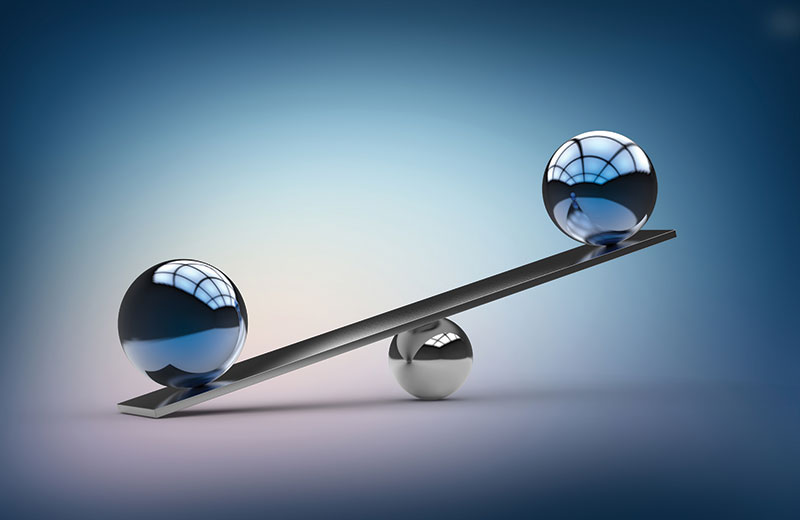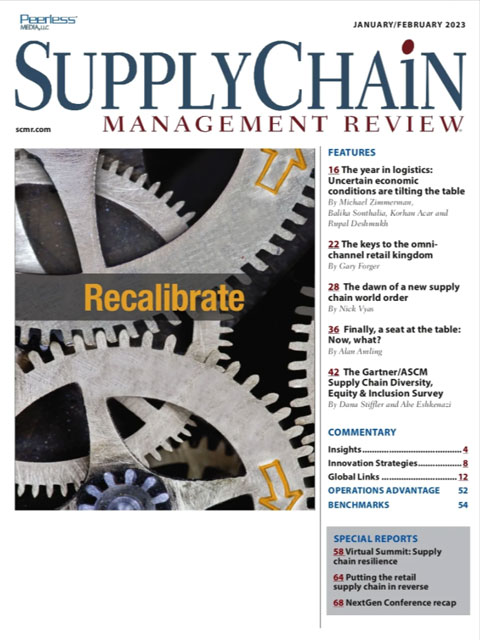Sorry, but your login has failed. Please recheck your login information and resubmit. If your subscription has expired, renew here.
January-February 2023
It feels like a normal holiday season. ”That was the report I got from the VP of global distribution at one of the country’s best known retail brands on the Monday before Black Friday. He added that the last time he felt that way was November of 2019. One of the perks of this job is that I get to talk to a lot of supply chain executives. In my conversations over the last year, I’ve learned two things. Operations, which was perhaps hardest hit at the start of the pandemic, has learned to operate in this new environment. Sure, there are still hiccups caused by absenteeism and inventory shortages. But those are situational—give them supply and… Browse this issue archive.Need Help? Contact customer service 847-559-7581 More options
The global pandemic drove unprecedented change in company supply chains and business models. Consider that ship-from-store was a nascent solution in 2019. Yet during the 2020 holiday season, the number of retailers using their stores as fulfillment centers grew by 80%. By 2022, brick-and-mortar retailers such as Walmart, Target, The Gap and American Eagle Outfitters had turned their internal logistics capabilities into third-party services.
An immediate challenge to their survival drove the ship-from-store change. Many retailers had to close their doors. At the same time, their parcel carriers were limiting capacity and raising prices. Retailers had to adapt, and most did. Ship-from-store was one of many business model changes that will not subside as the pandemic fades.
Adapting to changes in business environments has always been crucial to the survival of organizations. As Peter Drucker said, “The relevant question is not simply what should we do tomorrow, but rather what shall we do today to get ready for tomorrow.” But how do you drive change in your organization when you don’t have to? When the threat is years away, and the impact is uncertain. While most companies typically see the storm clouds of disruption on the horizon, their track record of being able to change in advance of trouble is getting worse.
Consider that the projected lifespan of Fortune 500 companies has fallen steadily since the late 1970s. Over the last decade, the average company tenure on the list was cut in half to 15 years to 20 years. In the next five years, it is projected to fall even further (see Figure 1). So, is this trend the inevitable fate of your company?

This complete article is available to subscribers only.
Log in now for full access or start your PLUS+ subscription for instant access.
SC
MR
Sorry, but your login has failed. Please recheck your login information and resubmit. If your subscription has expired, renew here.
January-February 2023
It feels like a normal holiday season. ”That was the report I got from the VP of global distribution at one of the country’s best known retail brands on the Monday before Black Friday. He added that the last time… Browse this issue archive. Access your online digital edition. Download a PDF file of the January-February 2023 issue.The global pandemic drove unprecedented change in company supply chains and business models. Consider that ship-from-store was a nascent solution in 2019. Yet during the 2020 holiday season, the number of retailers using their stores as fulfillment centers grew by 80%. By 2022, brick-and-mortar retailers such as Walmart, Target, The Gap and American Eagle Outfitters had turned their internal logistics capabilities into third-party services.
An immediate challenge to their survival drove the ship-from-store change. Many retailers had to close their doors. At the same time, their parcel carriers were limiting capacity and raising prices. Retailers had to adapt, and most did. Ship-from-store was one of many business model changes that will not subside as the pandemic fades.
Adapting to changes in business environments has always been crucial to the survival of organizations. As Peter Drucker said, “The relevant question is not simply what should we do tomorrow, but rather what shall we do today to get ready for tomorrow.” But how do you drive change in your organization when you don’t have to? When the threat is years away, and the impact is uncertain. While most companies typically see the storm clouds of disruption on the horizon, their track record of being able to change in advance of trouble is getting worse.
Consider that the projected lifespan of Fortune 500 companies has fallen steadily since the late 1970s. Over the last decade, the average company tenure on the list was cut in half to 15 years to 20 years. In the next five years, it is projected to fall even further (see Figure 1). So, is this trend the inevitable fate of your company?
SC
MR


Latest Supply Chain News
- Retail sales see gains in October, reports Commerce and NRF
- Balancing green and speed: Home delivery insights from the pandemic era
- AdventHealth named top healthcare supply chain by Gartner
- Geopolitical readiness in supply chains: Strategic challenges for leaders
- Unlocking retention: The role employee engagement plays
- More News
Latest Podcast

 Explore
Explore
Business Management News
- Retail sales see gains in October, reports Commerce and NRF
- Balancing green and speed: Home delivery insights from the pandemic era
- AdventHealth named top healthcare supply chain by Gartner
- Unlocking retention: The role employee engagement plays
- Can supply chain managers embrace an entrepreneurial mindset?
- Challenges to ESG reporting
- More Business Management
Latest Business Management Resources

Subscribe

Supply Chain Management Review delivers the best industry content.

Editors’ Picks





